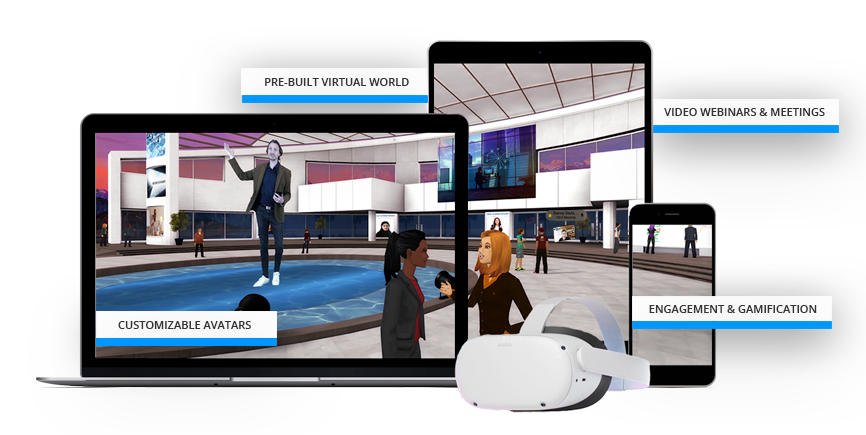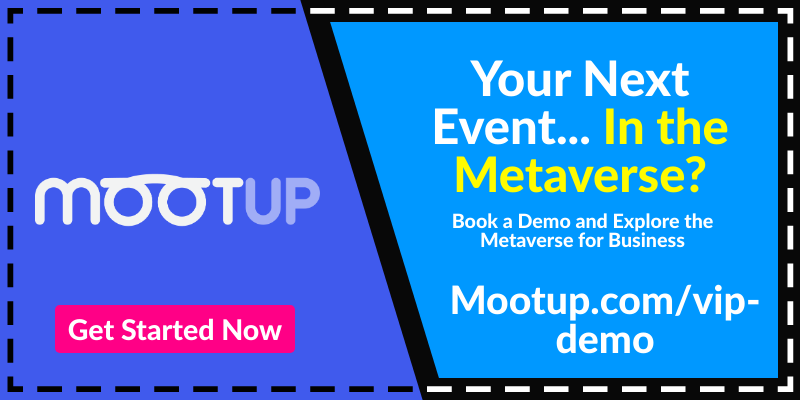In recent years, planning virtual events has become an essential skill for event industry professionals. As the world moves towards digital solutions, it is vital to comprehend how to craft captivating and productive virtual events for participants. In this blog post, we will investigate the intricacies of crafting a professional virtual event tailored to diverse audiences and incorporating necessary technological requirements for successful presentations.
We’ll explore the key decisions involved in planning and assessing technology needs for seamless presentations. Furthermore, you’ll learn about effective marketing strategies tailored specifically for planning virtual events, including pre-event Q&A sessions and targeted marketing on popular platforms.
Lastly, we will discuss methods to enhance attendee engagement in virtual environments through creative networking approaches and managing logistics & technology requirements effectively. Additionally, you’ll discover ways to stimulate post-event discussions and repurpose content for maximum impact.
Table of Contents:
- Virtual Event Planning Process
- Marketing Strategies for Virtual Events
- Enhancing Attendee Engagement in Virtual Environments
- Managing Virtual Event Logistics & Technology Requirements
- Post-event Discussion Stimulation & Content Repurposing
- Frequently Asked Questions Planning Virtual Events
- Conclusion
Virtual Event Planning Process
The virtual event planning process involves identifying decisions at each stage, nailing down technological requirements for presentations, and engaging with a broader audience. Utilize event planning software like Wrike to streamline the organization and management of your virtual events.
Identifying Key Decisions Throughout the Planning Stages
Identifying essential decisions to be made during the planning stages of a virtual event is vital for successful execution. This includes determining objectives for your event, selecting an appropriate platform such as MootUp, setting a budget, choosing speakers or presenters, creating an agenda or schedule, and developing marketing strategies. Outlining these elements early on in your planning efforts will help you stay organized and focused on achieving your goals.
Assessing Technology Needs for Seamless Presentations
In addition to making important strategic decisions during the initial stages of planning virtual events, it’s essential to assess technology needs well ahead of time. Some considerations include:
- Selecting a reliable streaming service capable of handling high-quality video content without buffering issues.
- Determining whether additional tools are needed for audience engagement features such as live chat functionality or interactive polls.
- Evaluating hardware requirements (e.g., microphones) for speakers and presenters who may not have access to professional-grade equipment at home.
- Ensuring adequate internet bandwidth is available both onsite (for hybrid events) and remotely (for fully-virtual attendees).
Considering these factors can help prevent technical difficulties from arising during presentations while ensuring that your virtual event runs smoothly and efficiently. Additionally, consider conducting a virtual event rehearsal to test your technology setup and troubleshoot any issues that may arise.
Planning a virtual event necessitates thoughtful deliberation of the choices to be taken and the technological needs that must be satisfied in order to ensure successful results. With this knowledge, marketers can then focus on creating effective marketing strategies for their events.
With MootUp, you can create and launch your own Metaverse that is fully customizable to your brand and offers seamless transitions between immersive experiences, providing an always-on virtual world for your visitors.
Key Takeaway:
A no-code platform is being developed to create and host virtual and hybrid events in the Metaverse. The topic of this discussion is planning virtual events where participants can use idioms and colloquialisms if necessary.
Marketing Strategies for Virtual Events
To ensure the success of your virtual event, it is crucial to implement effective marketing strategies that drive demand and increase registrations. By targeting platforms frequented by your audience and employing email marketing campaigns, you can generate anticipation among potential attendees using pre-event content such as sneak peek videos or relevant whitepapers.
Pre-event Q&A sessions to build buzz
One way to create excitement around your upcoming virtual event is by hosting pre-event Q&A sessions. These interactive discussions allow prospective attendees to engage with speakers or panelists before the main event, giving them a taste of what they can expect during the conference. This strategy builds buzz and encourages more people to register for your virtual event.
Targeted marketing on popular platforms
In addition to pre-event activities, consider leveraging popular social media platforms like LinkedIn, Facebook, Twitter, and Instagram for targeted advertising. Tailor your ads based on demographics and interests specific to your target audience.
- Create eye-catching visuals highlighting key speakers or topics at the event.
- Promote early bird registration discounts or exclusive offers through sponsored posts.
- Utilize hashtags related to industry trends or themes discussed during the conference.
- Encourage user-generated content by asking followers about their expectations from the upcoming event.
The goal is not just reaching out but engaging with potential participants effectively so they feel compelled enough to register for your virtual event. By combining these marketing strategies, you can successfully drive demand and increase registrations, ensuring a well-attended and successful virtual conference.

To maximize the success of virtual events, developing a comprehensive marketing strategy is essential. Creative networking approaches tailored for remote participants should be explored to further improve attendee engagement in these environments.
Key Takeaway:
A no-code platform is being developed to create and host virtual and hybrid events in the Metaverse. This project aims to simplify the process of planning virtual events, making it easier for event organizers to produce engaging experiences for attendees without requiring advanced technical skills or knowledge.
Enhancing Attendee Engagement in Virtual Environments
To boost attendee engagement within a virtual environment, event industry professionals need to think outside traditional time zones and serve attendees according to their respective locations worldwide. Implementing creative networking strategies like “speed dating” models or utilizing instant messaging platforms alongside small group workshops dedicated to fostering connections between participants can significantly improve the overall experience of your virtual event.
Catering to Global Audiences Beyond Time Zone Limitations
When planning virtual events, it’s essential to consider the needs of a global audience. This means scheduling sessions at various times throughout the day or offering on-demand content for those who cannot attend live presentations due to time zone differences. A helpful tool for managing this aspect is Time and Date’s World Clock Meeting Planner, which allows you to find suitable meeting times across multiple locations.
- Offer multiple session timings catering to different regions
- Provide recordings of live sessions for later viewing
- Incorporate real-time language translation services when necessary
Creative Networking Approaches Tailored for Remote Participants
The success of any event lies in its ability to facilitate meaningful connections among attendees. To achieve this during a virtual event, planners must adopt innovative networking methods that encourage interaction despite physical distance:
- Speed Networking Sessions: Similar to speed dating, these short one-on-one meetings allow participants an opportunity for quick introductions and exchanges with fellow attendees.
- Birds-of-a-Feather (BoF) Discussions: BoFs are informal gatherings centered around specific topics where people with similar interests can discuss, share ideas, and network. EventManagerBlog offers some great tips on how to facilitate these sessions virtually.
- Gamification: Integrate games or challenges into your virtual event platform that encourage attendees to interact with one another. This could include trivia contests, scavenger hunts, or collaborative problem-solving activities.
Incorporating these creative networking approaches will keep participants engaged and help them forge lasting connections beyond the confines of a traditional conference setting.
.png)
By utilizing creative networking approaches tailored for remote participants, virtual events can be enhanced to engage attendees beyond time zone limitations. With the right preparation and interactive elements, event professionals are equipped with the tools to manage virtual event logistics and technology requirements.
Key Takeaway:
A no-code platform is being developed to create and host virtual and hybrid events in the Metaverse. The topic is planning these events effectively, without mentioning the intelligence quotient.
Managing Virtual Event Logistics & Technology Requirements
Managing logistics and technology requirements in virtual event planning is crucial for a seamless experience. Every detail matters in ensuring your event runs smoothly, from speaker preparation to incorporating interactive elements into presentations.
Speaker Preparation Best Practices
To ensure top-notch presentations from your speakers, you must provide them with ample support throughout the process. Some best practices include:
- Regular communication: Keep in touch with speakers regularly leading up to the event and address any concerns or questions they may have.
- Detailed guidelines: Provide clear instructions on presentation formats, time limits, and technical requirements so that there are no surprises on the event day.
- Mandatory practice sessions: Require all speakers to participate in at least one rehearsal session before going live. This will help identify potential issues early on and allow for necessary adjustments. You can use platforms like MootUp, which offers an easy-to-use interface for organizers and presenters during rehearsals.
- Tech support availability: Have dedicated tech support staff available during rehearsals and throughout the event to assist with any technical difficulties that may arise.
Incorporating Interactive Elements into Presentations
Consider incorporating interactive elements within presentations to keep attendees engaged during virtual events. Here are some ideas you can implement:
- Polls & surveys: Add real-time polls or surveys using tools like Poll Everywhere to gather audience opinions and feedback during presentations.
- Q&A sessions: Encourage attendees to submit questions throughout the presentation, which speakers can address during designated Q&A segments. This promotes a connection between presenters and their viewers.
- Gamification: Incorporate games or quizzes into your virtual event plan to break up content-heavy presentations and keep attendees engaged. Platforms like Kahoot. Offer customizable game templates that can easily be integrated into your event schedule.
Taking these steps in managing logistics and technology requirements will contribute significantly to planning successful virtual events. By prioritizing speaker preparation, incorporating interactive elements, and paying close attention to detail, you’ll create an engaging experience for all participants.
To ensure a successful virtual event, it is essential to manage the logistics and technology requirements. With proper planning, post-event discussion stimulation and content repurposing can be maximized for maximum impact.
Key Takeaway:
A no-code platform is being developed to create and host virtual and hybrid events in the Metaverse. The preparation and care required for organizing these kinds of events are the main focus of this discussion.
Post-event Discussion Stimulation & Content Repurposing
To maximize the impact of your virtual event, it’s essential to keep the conversation going even after the event has ended. By encouraging post-event discussions and repurposing content from your conference, you can extend its life beyond its initial run time.
Encouraging Post-event Conversations
After a successful virtual event, attendees will likely have plenty to discuss. Create dedicated spaces on social media channels or within the MootUp platform to facilitate these conversations. You can host follow-up webinars or Q&A sessions with speakers to address lingering questions and maintain attendee engagement.
- Create discussion groups on platforms like LinkedIn or Facebook for attendees to share their thoughts and experiences.
- Prompt participants by asking thought-provoking questions related to key takeaways from the event.
- Schedule follow-up events such as webinars or workshops based on topics covered during the main conference.
Repurposing Content for Maximum Impact
In addition to stimulating post-event discussions, consider repurposing content from your virtual conference into various formats that can be shared via newsletters, websites, and social media platforms. This strategy extends the reach of your event and helps reinforce key messages among attendees who may want a refresher on specific topics discussed during presentations. Some ways you can repurpose content include:
- Bite-sized videos: Edit full-length presentations into shorter clips focusing on highlights or key points; these are perfect for sharing across social media channels like Instagram Reels or TikTok. Adobe Creative Cloud offers a range of applications to assist with video editing.
- Blog posts: Turn presentation transcripts or summaries into informative blog articles that your audience can easily share and read. Be sure to include relevant images, quotes, and links back to the original event content. You can use platforms like WordPress or Wix for creating engaging blog posts.
- Email newsletters: Share key takeaways from presentations in a digestible format via email newsletters sent out after the event. This helps reinforce learning and keeps attendees engaged even after the conference has ended. Mailchimp, for example, is an excellent tool for designing and sending email campaigns.
- Social media graphics: Create eye-catching visuals featuring memorable quotes or statistics from speakers; these make great shareable content on platforms like LinkedIn, Twitter, or Facebook. You can use design tools such as Canva to create stunning social media graphics.
Incorporating post-event discussions and repurposing content are effective ways to ensure your virtual events continue making an impact long after they’ve concluded. By actively engaging with attendees through various channels and formats, you’ll maintain their interest while reinforcing key messages from your conference – ultimately maximizing its value for all involved parties.
Key Takeaway:
A no-code platform is being developed to create and host virtual and hybrid events in the Metaverse. This topic focuses on planning such events, carefully considering audience engagement, content delivery, and technical requirements.
Frequently Asked Questions Planning Virtual Events
What type of virtual event are you planning?
The type of virtual event depends on your goals and audience. Common types include webinars, conferences, trade shows, workshops, product launches, and networking events. Consider the purpose of your event and tailor it to meet specific objectives while providing value for attendees.
How will you engage your audience during the event?
To engage audiences in a virtual environment, incorporate interactive elements such as live polls, Q&A sessions, chat rooms or breakout groups. Encourage social media interaction with hashtags or contests. Utilize engaging visuals and multimedia presentations to maintain attendee interest throughout the event.
What technology do you need to host a successful virtual event?
A successful virtual event requires reliable platforms for video streaming (e.g., Zoom, Crowdcast), content delivery (Hopin, vFairs), registration management (MootUp, Eventbrite) analytics tracking (Google Analytics/). Ensure all tools integrate seamlessly for a smooth user experience.
How will you measure success for your virtual event?
Determine key performance indicators (KPIs) before an online conference or meeting, including attendance rates, number of leads generated, social media engagement levels, and post-event survey feedback. Evaluate results against set targets and analyze data insights for continuous improvement in future events.
What budget have you allocated for the virtual event?
The budget should account for technology costs, speaker fees, marketing expenses, and any additional resources needed. Virtual events typically cost less than in-person events due to reduced venue and travel expenses; however, it’s essential to allocate funds strategically to ensure a high-quality experience that meets your objectives.
Conclusion
Overall, planning virtual events is a complex and challenging process. It requires careful consideration of logistics, promotion strategies, technical requirements and more to ensure the event runs smoothly. With proper preparation and execution, you can create an engaging experience for your attendees while achieving success with your goals. Planning virtual events can be daunting, but it doesn’t have to be overwhelming; following these steps sets you up for success.
Elevate your Metaverse to be “futureproof” with MootUp – a browser-based platform that allows access from smartphones, tablets, laptops, and VR/AR headsets without downloading or software installation, ensuring seamless access across devices.
Take your virtual events to the next level with MootUp! Our no-code platform makes it easy for you to plan, produce and host hybrid or fully virtual events in the Metaverse.

